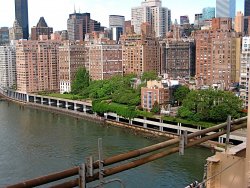
MAY CONTAIN NUTS

Search Shorpy
SHORPY ART

Framed or unframed, desk size to sofa size, printed by us in Arizona and Alabama since 2007. Explore now.
Join and Share
Ad-Free Shorpy
Shorpy is funded by you. Patreon contributors get an ad-free experience.
Learn more.

Recent comments
- Side Winder
- Air Quality?
- Sojourner Truth riot
- None were so blind(ed)
- The less famous sister
- Good ol' days?
- Rise and Fall
- Goo Goo Ga Joob
- Ticket Retention
- Not the only one
- Vagaries of War
- Killed by Amtrak
- Back to the Future
- Wanted --
- If you can't stand the light
- Centralized Traffic Control, I believe
- What's really happening
- Heckuva remote control!
- Sometimes — Things Go Bump!
- I SEE THE LIGHT
- Union Switch and Signal Company
- Get That Light Out Of My Eyes
- Eggs. Eggs. Eggs. The Egg Man is Here!
- Foreboding caption
- Famous Hollywood faces
- Not just S&P
- re: Those things in the jar
- Up In Smoke
- Medical Smoking
- Quick fix
Member Photos
The Shorpy
Print Emporium
Print Emporium
Search Shorpy
Search results -- 30 results per page
- Murray Street Fire: 1915
- February 19, 1915: "Murray Street Fire" in Manhattan. Who can help us fill in the details? View full size. 5x7 glass ... Posted by Dave - 09/08/2011 - 7:33pm -
![Murray Street Fire: 1915 February 19, 1915: "Murray Street Fire" in Manhattan. Who can help us fill in the details? View full size. 5x7 glass negative, George Grantham Bain Collection.
"CORNERED ON THIRD FLOOR"Here's the news story from the New York Times Archive ...
"The two policemen ran one block south and saw the fire in a five-story brick building a few doors west at 69 Murray Street. The ground floor was occupied by J.B. Colt Company, manufacturer of lighting fixtures, and the upper floors by the Griffin Manufacturing Company, makers of shoe polish."
[Fascinating. Thanks! - Dave]
(The Gallery, Fires, Floods etc., G.G. Bain, NYC)](https://www.shorpy.com/files/images/18471u.thumbnail.jpg)
- Number Please: 1917
- ... on lower Broadway, one of my favorite buildings in lower Manhattan. It's just Doric order, stacked up about 22 floors. It's now the ... Posted by Dave - 07/08/2008 - 11:29pm -
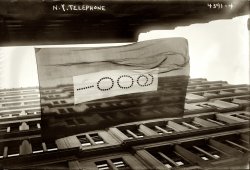
- Liberty: 1919
- ... was a banker earning $5000 per annum working for Chase Manhattan Bank 18 Pine Street NYC.
Sometime after this Elizabeth and Ernest ... Posted by Dave - 08/26/2012 - 11:46am -
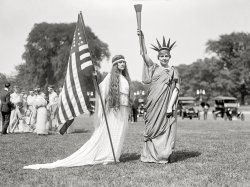
- The Blizzard: 1899
- ... a group of smokestacks which _might_ be the Hudson & Manhattan RR powerhouse in Jersey City, seen from an angle such that only three ... Posted by Dave - 01/26/2015 - 12:21pm -
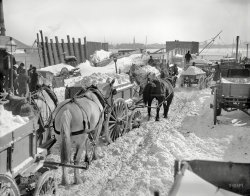
- All Along the El: 1900
- Manhattan circa 1900. "The Bowery, New York." The tracks of the Third Avenue El ... Posted by Dave - 04/25/2017 - 11:05am -
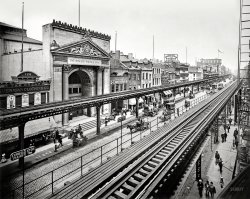
- Pennsy Parthenon: 1909
- Manhattan circa 1909. "New Pennsylvania Station, New York, N.Y." The Beaux-Arts ... Posted by Dave - 03/31/2017 - 4:54pm -
![Pennsy Parthenon: 1909 Manhattan circa 1909. "New Pennsylvania Station, New York, N.Y." The Beaux-Arts behemoth whose demolition in 1963 lit a fire under the nation's armchair architects. 8x10 inch dry plate glass negative. View full size.
Hold your HorsesWhile I was working in the Hotel Pennsylvania (where that hole is in the foreground) a few years ago, I realized that the bulk of the construction material for the Station, and the hotel, were brought there by horse and wagon.
Now look at the size of the building materials.
Did you know?That it took about nine years to build the station. It was completed about a year after this picture was taken. The building itself covers about 8 acres and is about 1150 ft. tall. When the station was demolished in 1963, only the above ground portion was torn down. The train tracks and lower platforms still exist. This is now the site of Madison Square Garden and the Penn Hotel.
[Over a thousand feet tall? I definitely did not know that. - Dave]
The size of itThe size and scale of the building becomes really apparent when compared to the men working on the roof.
(The Gallery, DPC, NYC, Railroads)](https://www.shorpy.com/files/images/SHORPY-4a23399a.thumbnail.jpg)
- Metropolis Rising: 1900
- Manhattan circa 1900. "New York's business district from the Woodbridge ... Posted by Dave - 10/10/2017 - 3:16pm -
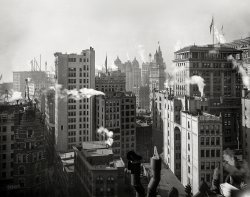
- Lux Nocturna: 1933
- January 6, 1933. "Manhattan from St. George Hotel in Brooklyn to financial district, night view." ... Posted by Dave - 12/19/2016 - 1:33pm -
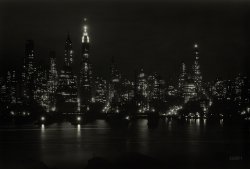
- Field of Tweens: 1906
- Manhattan circa 1906. "Boys' playground, Central Park, New York." 8x10 inch dry ... Posted by Dave - 02/23/2018 - 9:36pm -
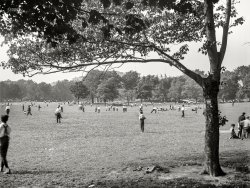
- Bronx Saloon: c. 1908
- ... a bartender in the Washington Heights neighborhood of Manhattan. The arrival of Prohibition in 1920 put Edward Hawley Ingles out of ... Posted by truenorth64 - 12/08/2010 - 2:04pm -
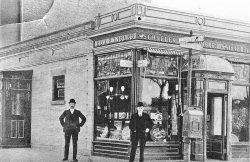
- Doc Dembling: 1935
- ... behind the counter of his drugstore at 60 W 8th St in Manhattan NYC, around 1935. I have the feeling this picture may have been taken ... Posted by Nicholas West - 09/19/2011 - 7:57pm -
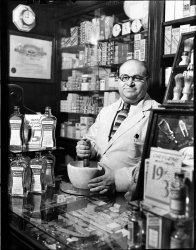
- Gloria Vanderbilt: 1924-2019
- ... and of jet-set romances, died on Monday at her home in Manhattan. She was 95.
— New York Times
January 1955. ... Posted by Dave - 06/20/2019 - 1:50pm -
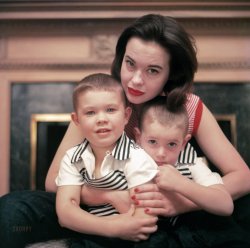
- Zone of Quiet: 1925
- ... saw a sign exactly like that on the Upper East Side of Manhattan, next to a hospital. I've always wondered how the police would ... Posted by Dave - 03/06/2017 - 2:35pm -
![Zone of Quiet: 1925 January 1925. Washington, D.C. "Wardman Motor Co. and Carlton Garage, 1108-14 Vermont Avenue." Dealer in Willys-Knight and Overland cars. We take our title from the sign on the lamppost: ZONE OF QUIET: ALL UN­NECESSARY NOISES PROHIBITED. 8x10 glass negative, National Photo Co. View full size.
A long lost friend!Nearly empty milk bottle out on the windowsill to keep cool.
[Plus another one over at the Burlington! - Dave]
Kudos! Finding the second bottle at the Burlington takes a sharp eye! (Brief round of polite applause.)
[Please, no applause -- just throw money. - Dave]
Unnecessary Noise ProhibitedI once saw a sign exactly like that on the Upper East Side of Manhattan, next to a hospital. I've always wondered how the police would enforce that regulation. Would an officer approach an offender and say: "Was that noise really necessary? Because if not, I'm gonna have to book you!"
Still can hear my Dad holleringfor leaving an inch of milk in the bottle. Why didn't you just finish it??
(The Gallery, Cars, Trucks, Buses, D.C., Natl Photo)](https://www.shorpy.com/files/images/SHORPY-32352u.thumbnail.jpg)
- The Corner: 1905
- ... is - the single most expensive piece of real estate in Manhattan, it is highly unusual that a taller building was replaced by a ... Posted by Dave - 08/05/2018 - 4:08pm -
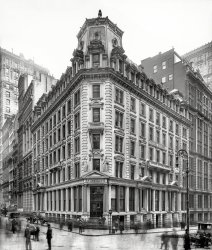
- City Hall Park: 1910
- Manhattan circa 1910. "Park Place (City Hall Park) and New York City Hall." ... Posted by Dave - 10/07/2019 - 12:07pm -
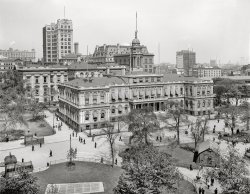
- You Better Watch Out: 1940
- ... The New York Times, for 30 x 22 prints to decorate its new Manhattan headquarters.
(The Gallery, Arthur Rothstein, Cars, Trucks, ... Posted by Dave - 12/18/2007 - 11:43pm -
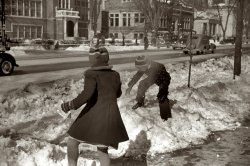
- In a Jiffy: 1942
- ... in the early part of the war. Imagine driving in Manhattan traffic with no streetlights, all buildings dark, and it being ... Posted by Dave - 07/24/2016 - 2:22pm -
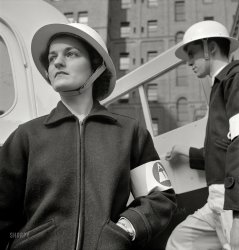
- Man About Town: c. 1920s
- My grandfather strolls down Madison Avenue in Manhattan, near the corner of 44th St. on a sunny day in the 1920s. View full ... Posted by thomas - 02/02/2011 - 9:11am -
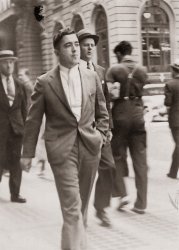
- Corporate Canyon: 1941
- October 1941. "Skyline of Midtown Manhattan from Radio City (Rockefeller Center)." Medium format negative by ... Posted by Dave - 08/16/2020 - 1:40pm -
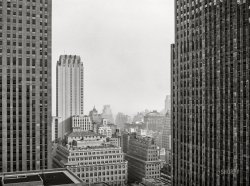
- Trash Talk: 1938
- ... View full size.
In the beginning In the '60s in Manhattan (and presumably in the other boroughs as well), in every alley and on ... Posted by Dave - 10/06/2018 - 9:39am -
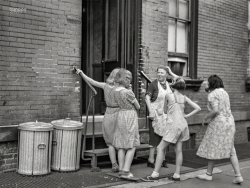
- The Yates: 1905
- ... and demolished in 1971, "the most elegant hotel outside Manhattan" is now a parking lot. View full size.
Urban Renewal Ah ... Posted by Dave - 07/28/2017 - 3:35pm -
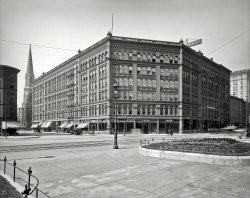
- Three Tall Ships: 1903
- New York circa 1903. "Manhattan from under the Brooklyn Bridge." 8x10 inch dry plate glass negative, ... Posted by Dave - 07/26/2017 - 12:23pm -
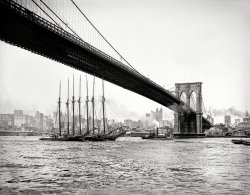
- A Walk on the Water: 1907
- New York circa 1907. "Manhattan from the Brooklyn Bridge." 8x10 inch dry plate glass negative, ... Posted by Dave - 07/16/2013 - 9:16am -
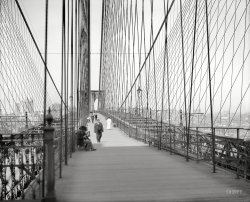
- KP Cutups: 1943
- ... organization that has operated on the Upper East Side of Manhattan since 1895 helping waves of new immigrants adjust to life in the US. ... Posted by Dave - 03/18/2017 - 1:52pm -
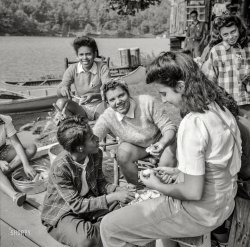
- Queensborough Bridge Centennial
- ... from center span. The view is of the buildings along the Manhattan side of the river. We see the FDR Driver passing under the Beekman ... Posted by Mr Mel - 06/17/2009 - 11:20am -
- Potentate: 1970s
- ... Fleming at the Knickerbocker Cottage on 6th Avenue in Manhattan. Mecca Shrine is still very much in existence. The Potentate of a ... Posted by Knobbynah - 05/25/2012 - 10:52pm -
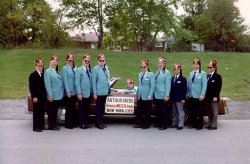
- Tanks for Nothing: 1941
- ... looking northwest, or relatively west with respect to the Manhattan street grid.
(The Gallery, Arthur Rothstein, NYC) ... Posted by Dave - 08/24/2018 - 10:47am -
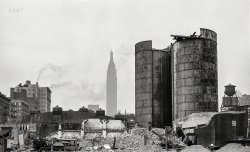
- Black Jack in NYC
- ... settled on the west side, what is now known as Chelsea, in Manhattan. This photo has generated many stories about Grandpa, and his banjo ... Posted by Elizabeth.H - 02/01/2013 - 9:01pm -
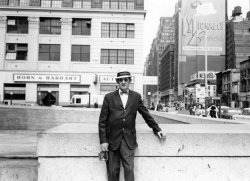
- Mr. & Mrs. Robert Vanella 1921
- ... operated Vanella Funeral Chapel at 27-29 Madison Street in Manhattan. The funeral home still stands and is operated by distant relatives ... Posted by ckny54 - 02/03/2012 - 11:18pm -
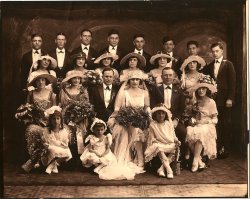
- 800 ft. over Lexington Avenue
- ... on a rope from the spire of the Chrysler Building in Manhattan. Photo by Douglas Winchester 1977.
Just hanging out? Why were ... Posted by Jack R. - 01/17/2012 - 12:53pm -

























